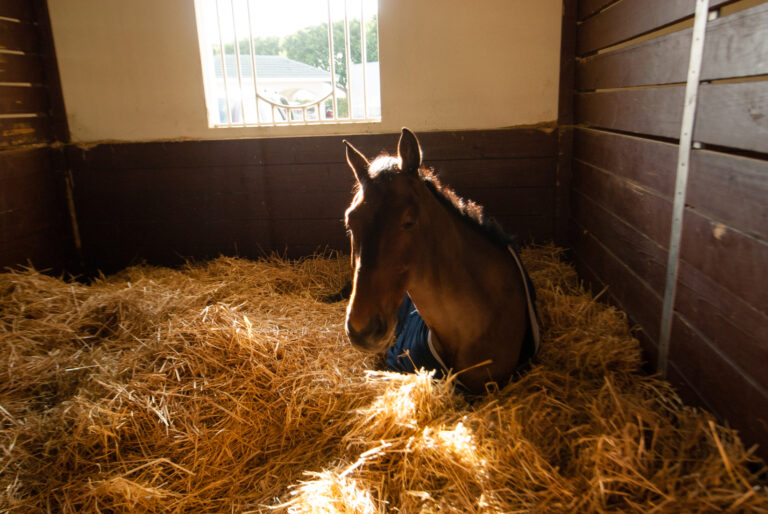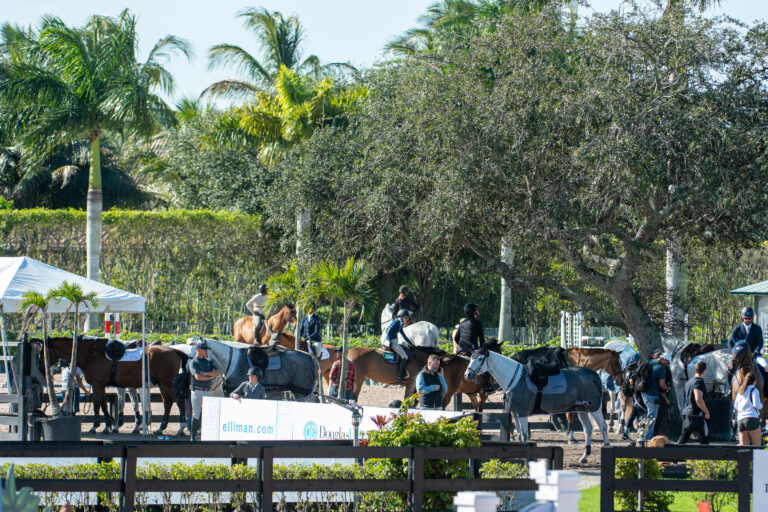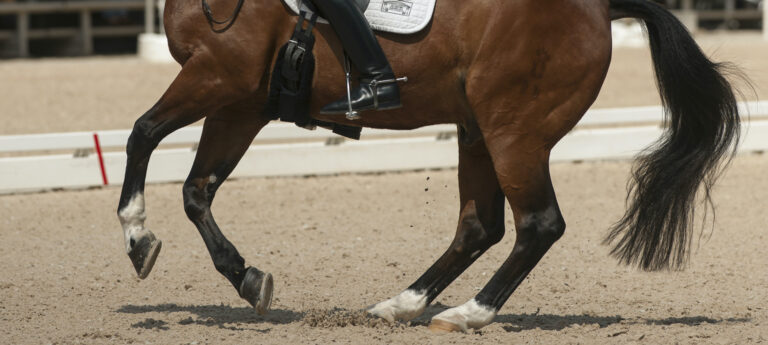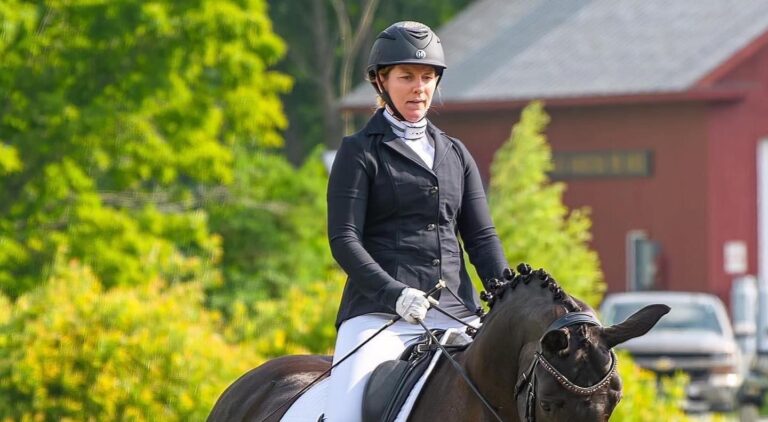The goal of changing a horse’s postural habits to help him move better often derails in the first few minutes of a ride. Why? In the horse’s body, different muscles serve different purposes, and often dressage riders fail to activate the right muscles. Furthermore, activating the wrong muscles can cause other problems, like stiffness or limited flexion of joints, which are also counterproductive to the goals of dressage.
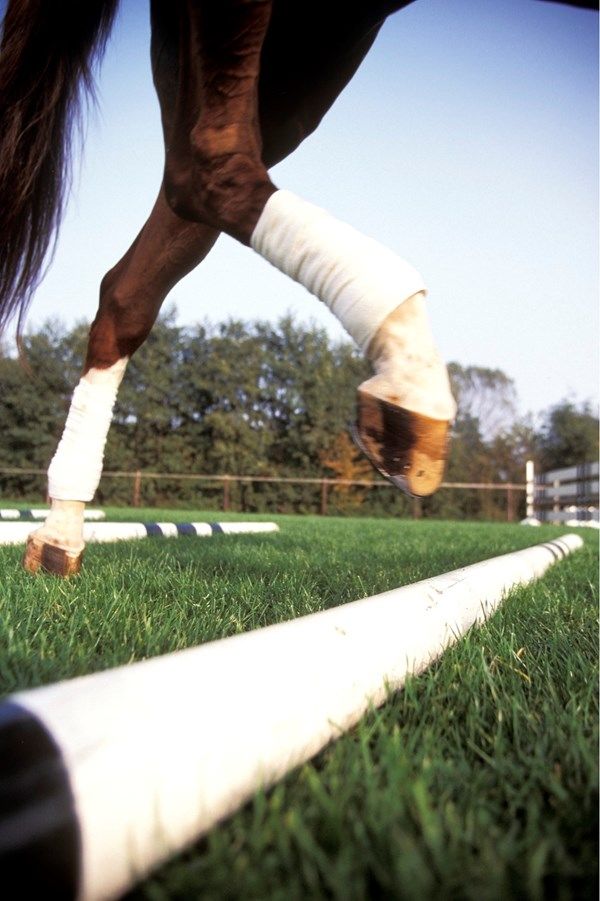
As an Amazon Associate, Dressage Today may earn an affiliate commission when you buy through links on our site. Products links are selected by Dressage Today editors.
During training sessions, many riders activate the horse’s “gymnastic” muscles—or large, exterior muscles that are suited for locomotion. These muscles are responsible for making sure that the horse covers ground to move from one place to another, but they are not effective at communicating with the nervous system to establish new muscle patterns, or muscle memory. Overdeveloping a horse’s gymnastic strength can quickly result in stiffness and when it does, it alters a horse’s reflex system and inhibits joint flexion.
As an example, a horse can have very strong back muscles but be highly compromised in how well he can move. According to veterinarian Dr. Gerd Heuschmann, tension arising from a hyper-toned back actually slows down a horse’s hind legs and creates a habit of bracing through his body rather than improving agility and balance. Likewise, gluteal muscles, when strengthened disproportionately to their neighboring smaller muscles, can restrict the hind legs from swinging freely. Many of today’s riders have misinterpreted the concept of strength, according to Heuschmann. They spend too much time trying to drill the big, flashy gaits they think they need for dressage. This repetition produces rigidity and asymmetry.
“You have to make your horse an athlete. A locomotional horse gets dull,” he said, referring to horses who have been trained with an emphasis on strengthening their toplines and hindquarters, or to have big gaits every day while their finely controlled muscle groups or their postural muscles, such as the multifidi group alongside the vertebrae or the pelvic stabilizers have been neglected.
When riders need to change muscle patterns, or muscle memory, they should focus on stimulating the smaller muscles deep in the horse’s body, close to his spine and around his joints, often called the intrinsic muscles. In addition to supporting the locomotion muscles, they are highly supplied with nerves and neural pathways. Think of them as storing the language for your horse’s movement. By activating these muscles ahead of and in complement to the larger muscles, engaging new pathways are established and/or existing ones become refined.
Heuschmann said for most riders this can be achieved through riding at slower speeds, referencing the slow warm-up jog advocated by Alois Podhajsky of the Spanish Riding School. Sometimes called the “pony trot,” this slow gait resembles a casual Western jog and allows the horse to move around easily, flexing his joints and swinging through his spine, before more impulsion is added. Podhajsky also noted one of the most beneficial rehab protocols used by the cavalry. It involved riding horses on a long rein up and down hills in the forest until the horse’s neck dropped and relaxed, allowing the nervous system to change. Sometimes this required months, but until then things could not change. “Any horse who is tense in the poll or back is losing his natural rhythm,” said Heuschmann. As tension releases from the large back muscles that are blocking good movement, the smaller back muscles become activated.
According to Sarah le Jeuene, DVM, at the Equine Integrative Sports Medicine Center at U.C. Davis, in general, it is easier to train the locomotive muscles and harder to train the postural muscles, which require targeted exercises. However, this aspect of training requires further research, le Jeuene acknowledged, since much of our current physical-therapy data applied to horses is transferred from human fitness studies but is not always accurate for a quadriped stance.
“What we know is that pain inhibits normal muscular activation and can actually lead to inactivation of normal muscular pathways,” said le Jeuene. Pain can result from actual injury, excess tension or from imbalanced muscular development. The most effective daily strategy for changing horses’ muscle patterns seems to be to first relieve some of this pain or stiffness through physical techniques like trigger points, moving joints and dynamic stretches, then perform corrective calisthenics and then proceed to a regular riding workout.
Commit to using two or three of the exercises below for the first 10 minutes of your warm-up phase each day before you begin your regular ride. Try this for six weeks and notice any changes. By communicating directly with the pathways that store patterns, you should see substantial progress. Experiment with different exercises, as some will produce more dramatic results for your horse than others. Find the ones that yield measurable changes.
Exercises 1 and 2: Release Tension to Improve Range of Motion
For Jim Masterson, whose Masterson Method bodywork has been used for the United States Equestrian Team, taking a horse’s joints and limbs through full range of motion without resistance or tension is paramount to improving athleticism. This is best accomplished each day, he believes, when the locomotion muscles are not yet engaged. Three things happen with movement in a fully relaxed state, according to Masterson. First, the horse feels specifically where the tension is. Next, he releases the tension. Last, the horse’s nervous system is reprogrammed. “The key isn’t in the amount of movement, but in the amount of relaxation in the movement. Asking for even a tiny range of motion in a relaxed state is 10 times more effective than asking for a large movement in an nonrelaxed state,” Masterson explained. He recommends two simple exercises to apply this principle of releasing tension to the postural muscles of the horse’s spine:
1. The first exercise targets the vertebrae of the poll, atlas and neck. Stand at your horse’s head on the near side with the fingers of your left hand resting softly on his nose. Place two fingertips of your other hand gently on his neck about a hand’s width behind and below his ear. Soften both arms and hands so that you are barely touching the hair. With the left hand, gently wiggle the nose about half an inch from side to side. Do four wiggles and stop. This is to check that the movement is still relaxed. Wiggle again and then stop. Repeat this a few times. If the horse finds this uncomfortable, then he is feeling tension in the postural muscles of the spine in this area. Don’t try to stop him from fussing or tossing his head. Instead, soften your hands even more and wiggle with even tinier movements. This will give him the opportunity to release the tension more comfortably. Do both sides in small increments, a little every day. “The reason a wiggle works is that it’s a tiny movement in a relaxed state that the horse cannot brace against,” said Masterson.
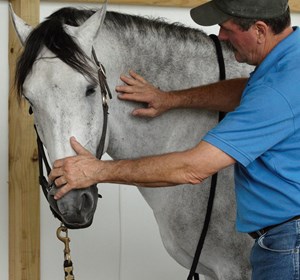
2. The second exercise targets the entire spine, from the sacrum to the poll. Stand at your horse’s hind end, alongside his hip, with your right hand resting softly on the sacrum above the base of his tail. Relax both arms and hands. Using the heel of your right hand, gently wiggle the hind end about an inch from side to side, looking for a tiny wave or rhythm through to the nose. Your horse’s head should swing from side to side. Continue for at least two minutes.
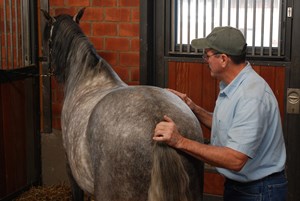
Exercise 3: Utilize Sensory Re-education Paths
After releasing tension from restrictive areas of the horse’s body, you can then introduce new muscular patterns with the following corrective exercises during the slower portion of your warm-up. The use of sensory re-education paths has become popular at rehabilitation facilities because they enhance a horse’s proprioception (his awareness of his own body position), which, in turn, creates a horse who can move with fluidity and knows well where his feet are.
These paths use 3-meter segments of alternating surfaces that a horse walks through for a total of 30 or more meters. Pebbles, firm ground, water, sand and grass make up each segment. Therapists use these paths to wake up a horse’s neuroreceptors, which deliver mobility to areas of the neuromuscular system that are not being accessed. Especially for horses who train predominantly on manicured arena surfaces, these paths have proven successful in tuning up a horse’s limb reaction time, joint flexion and recruitment of postural muscles.
In the absence of a formal sensory re-education path, you can create a similar experience by treading across the surfaces available immediately near your barn: gravel, wood chips, pavement and grass. Aim to walk or jog slowly across these changing surfaces three times per week for five to 10 minutes. Try not to micromanage your horse; allow him to find his footing even if he trips.
Exercise 4: Add a Ditch or a Drop
Commonly ridden by three-day eventers, a ditch, where the horse negotiates a steep downhill drop for three to four steps and then immediately climbs back up the other side, requires coordination between the front and hind end plus quick adjustments of balance. These adjustments help the horse lift the base of his neck and calibrate his pelvic stability. They also help fix one-sidedness since the horse has to flex and push off both hind legs equally. When a horse has become clever at traveling in a slightly crooked posture in the arena, riding a ditch will magnify that misalignment and allow riders to correct it in a slow, finely controlled manner.
If you have access to a ditch, ride across it in a controlled walk with the horse’s body absolutely straight, no hindquarters swinging sideways, five to eight times daily. Absent a ditch, you can improvise by riding up and down a short steep bank or down into a creek and out the other side. Another option is to build a raised pedestal or platform that the horse steps up onto and then off of.
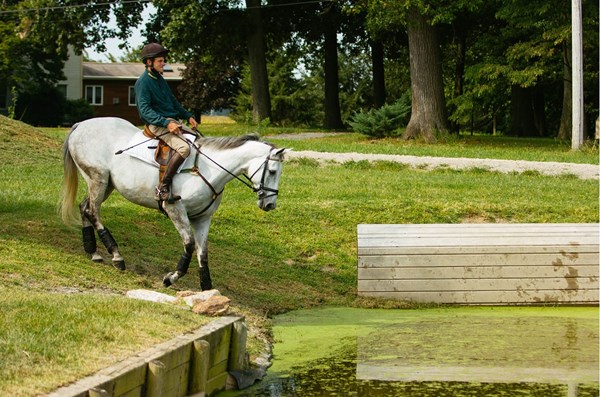
Exercise 5: Step Sideways
Sideways movements promote mobility of intervertebral and hip joints while recruiting the small muscles that stabilize them because they require rearrangement of neuromuscular coordination. The simple exercise of turn on the forehand, for example, when executed correctly, mobilizes the rib cage and frees up restriction in a horse’s ventral muscle chain, which connects his pubic bone and abdomen to his jaw and tongue. Movement therapists sometimes refer to this as a Pilates maneuver for horses. Either mounted or from the ground, perform three full turns on the forehand in both directions every day, making a 360-degree rotation each turn. The horse’s hind legs must cross to form the letter X with each stride. Check to ensure an evenness of crossing over in both directions.
Exercise 6: Poles with Purpose
Ground-pole routines appear frequently in rehab programs or to correct neurological misfirings because they play a role in altering a horse’s patterned movements and in recruiting stabilizing muscles. As a horse takes measured strides with distances and heights set by poles, he corrects gait irregularities and poor rhythm. These gait abnormalities can include uneven use of the hind legs, persistent crookedness and habits of bracing his neck. Depending on which condition needs to be corrected, a variety of pole routines can be used. The following patterns target hip stabilizers, improve joint flexion and resolve muscular bracing.
A. Snake Over Poles. Place six to eight poles, touching end to end, in a long, straight line either directly on the ground or raised to a height of 8 inches. In a slow walk with light rein contact, ride a tight serpentine that crosses back and forth across the line of poles. Your loops should be very small so that you remain close to the pole rather than drift out, away from it. Repeat several times.

B. Raised Fan. Use five poles to create a fan shape with the inside ends of the poles raised 8 inches off the ground. Place the raised ends of the poles so they are 2 feet apart from each other. Measure the center of each pole 4 feet apart from each other. Begin by riding around the inside edge of the fan on a tiny, slow-motion circle. Be sure your horse takes only a single step between each pole. Now, enlarge your circle to cross over the outer edge of all five poles. Try to get three steps between each pole. Continue repeating this sequence.
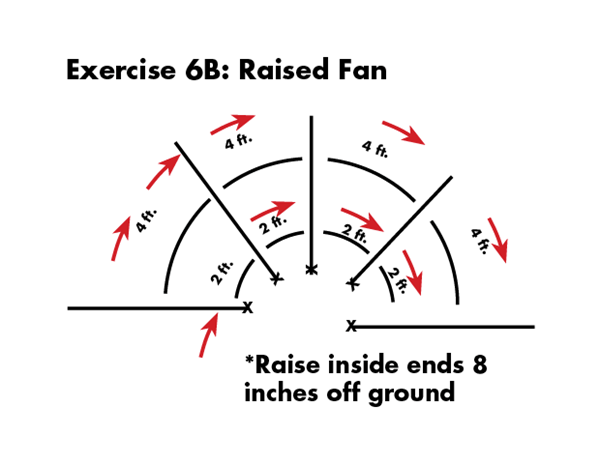
C. Pick-Up Sticks. Using as many poles as you have access to, scatter them around the arena in a random fashion. Place some close to one another, others far apart and at all kinds of angles. Now ride around the arena in a walk/jog, crossing over the poles with loops, curves and zigzags. Cross the poles using numerous approaches—straight across, obliquely. Ride for three-minute circuits like this, constantly changing your order of riding over the poles. After each circuit, rest briefly and then repeat.
Especially when training programs are proceeding smoothly, it can be tempting to overlook the importance of routines like the ones above. But remember: Every athlete needs to constantly keep his muscles and movement patterns balanced and tension-free. Only through consistent recruitment of the nervous system without involvement of the gymnastic system can we do this. By paying attention to these small details we often produce enormous results.
To read more from Jec Ballou, check out her books:
101 Dressage Exercises for Horse & Rider
The Unscheduled Dismount: And Other Humor from a Life with Horses
Equine Fitness: A Program of Exercises and Routines for Your Horse


